SAFFRON
An
Anti-Depressant Herb
BACKGROUND
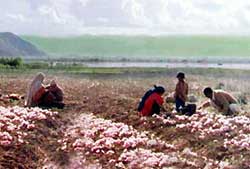 Saffron
is an herb most people are unlikely to utilize, either for medicinal
or culinary purposes, primarily because the material has a justified
reputation for being extraordinarily expensive. Bulk quantities of
relatively low-grade saffron can reach upwards of $500/pound, while
retail costs for small amounts may exceed 10 times that rate. But,
avoiding this valuable spice might be unnecessary because of the
small quantity needed: in medicinal use, 1–3 grams in
decoction, 0.5–1.5 grams ingested as powder, or 30 mg of its
dried extract per day is considered adequate in standard applications
(described below). For culinary use, just a few strands are
sufficient to flavor food (about 2–4 strands per person; there
are about 70,000–200,000 strands per pound).
Saffron
is an herb most people are unlikely to utilize, either for medicinal
or culinary purposes, primarily because the material has a justified
reputation for being extraordinarily expensive. Bulk quantities of
relatively low-grade saffron can reach upwards of $500/pound, while
retail costs for small amounts may exceed 10 times that rate. But,
avoiding this valuable spice might be unnecessary because of the
small quantity needed: in medicinal use, 1–3 grams in
decoction, 0.5–1.5 grams ingested as powder, or 30 mg of its
dried extract per day is considered adequate in standard applications
(described below). For culinary use, just a few strands are
sufficient to flavor food (about 2–4 strands per person; there
are about 70,000–200,000 strands per pound).
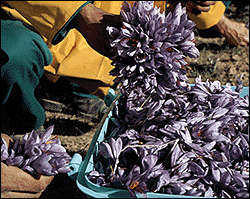
In some countries, such as Spain, Iran, and India, people know that saffron is worth its price and make good use of it. To meet the demand, world annual production is about 265 tons per year, which is grown on about 90,000 acres of land (if efficiently cultivated, each acre produces about 6 pounds of saffron a year). It takes about 170–200 hours of work to collect the flowers and remove the stamens for drying in order to produce just 1 pound of saffron, which is a large part of the expense for the spice. Saffron mainly grows in arid territory with sandy soil, under hot and dry summers, often requiring irrigation.
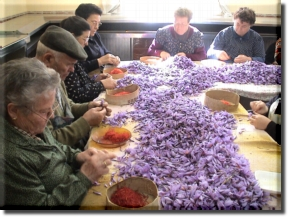 Saffron’s
high cost has become an attractive factor for one potential use: as a
substitute crop for opium cultivation in Afghanistan. Afghanistan is
the world’s second largest supplier of opium poppies used in
the drug trade (the largest is the “golden triangle” and
surrounding regions in Southeast Asia); opium is one of the major
sources of income for Afghanistan. In 2002, about 3,400 tons of
opium was produced there, most of it ultimately going to heroin
addicts in Europe. Since Afghanistan is in the saffron growing
region, there is some potential for this crop as an economic
substitute; still, saffron is estimated to bring in only about 3/4
the income of opium farming.
Saffron’s
high cost has become an attractive factor for one potential use: as a
substitute crop for opium cultivation in Afghanistan. Afghanistan is
the world’s second largest supplier of opium poppies used in
the drug trade (the largest is the “golden triangle” and
surrounding regions in Southeast Asia); opium is one of the major
sources of income for Afghanistan. In 2002, about 3,400 tons of
opium was produced there, most of it ultimately going to heroin
addicts in Europe. Since Afghanistan is in the saffron growing
region, there is some potential for this crop as an economic
substitute; still, saffron is estimated to bring in only about 3/4
the income of opium farming.
 Iran,
the world’s largest producer of saffron, and a neighbor to
Afghanistan, has been investing in research into saffron’s
potential medicinal uses. Much of the work surrounds its traditional
application for alleviating depression. One of the Iranian groups
carrying out saffron research is headed by Shahin Akhondzadeh
(pictured right), at the Roozbeh Psychiatric Hospital in the Tehran
University of Medical Sciences, who has studied the use of several
drugs and herbs for mental disorders, such as depression, ADHD,
Alzheimer’s disease, autism, opiate dependence, and epilepsy.
The clinical findings suggest that saffron is a safe and effective
antidepressant. For example, in a randomized, double-blind study, 30
mg of saffron extract (in capsules) given for 6 weeks resulted in
significant alleviation of depression compared to those on placebo,
and did so without evident side effects (1). This study was a
follow-up to a preliminary trial in which the same saffron
preparation performed as well as imipramine for treating depression
in a double-blind trial (2). In further preliminary work, saffron
was compared to the drug fluoxetine (often known by the brand product
Prozac); it was found that saffron performed as well as the drug in
treatment of both depression and epilepsy (3). Pharmacology studies
done in Iran (4) and Japan (5, 6) have confirmed an anticonvulsant
activity in the extract of saffron.
Iran,
the world’s largest producer of saffron, and a neighbor to
Afghanistan, has been investing in research into saffron’s
potential medicinal uses. Much of the work surrounds its traditional
application for alleviating depression. One of the Iranian groups
carrying out saffron research is headed by Shahin Akhondzadeh
(pictured right), at the Roozbeh Psychiatric Hospital in the Tehran
University of Medical Sciences, who has studied the use of several
drugs and herbs for mental disorders, such as depression, ADHD,
Alzheimer’s disease, autism, opiate dependence, and epilepsy.
The clinical findings suggest that saffron is a safe and effective
antidepressant. For example, in a randomized, double-blind study, 30
mg of saffron extract (in capsules) given for 6 weeks resulted in
significant alleviation of depression compared to those on placebo,
and did so without evident side effects (1). This study was a
follow-up to a preliminary trial in which the same saffron
preparation performed as well as imipramine for treating depression
in a double-blind trial (2). In further preliminary work, saffron
was compared to the drug fluoxetine (often known by the brand product
Prozac); it was found that saffron performed as well as the drug in
treatment of both depression and epilepsy (3). Pharmacology studies
done in Iran (4) and Japan (5, 6) have confirmed an anticonvulsant
activity in the extract of saffron.
A potential deterrent to medicinal use of saffron comes about because erroneous information related to saffron toxicity has appeared, especially in internet presentations, but also in books. The reports mention serious adverse effects from as little as 5 grams (about 3 times the medicinal dose), and fatal doses of just 20 grams have also been mentioned. By contrast, all recent research reports indicate that saffron is non-toxic. Why the discrepancy?
The most likely reason for this impression was writers initially confusing toxic meadow saffron with non-toxic saffron; from there the reports were simply repeated. Meadow saffron, also called wild saffron or Autumn crocus (Colchicum autumnale) contains the toxic compound colchicine (used primarily in the treatment of gout). It appears that the literature references to saffron acting as a toxin causing severe spontaneous bleeding or even death with just a few grams are primarily the result of ingestion of meadow saffron (or other materials) but not true saffron. These reports of adverse effects are old ones; for example, this oft-repeated information is relayed in the 1987 German E Commission report, which, in turn, is based on comments in other literature now over 50-years-old that did not include an analysis of the materials ingested or other details. Meadow saffron is not a substitute for true saffron; rather, it is sometimes ingested accidentally when collected mistakenly as a source of wild garlic. However, it is often simply called saffron, and articles reporting on its toxicity may list Crocus sativus as the botanical name, yet refer instead to meadow saffron in the description of uses (e.g., treating arthritis and gout) and toxicity, showing how easily these two are interchanged in reporting. Today, all saffron is cultivated; the material on the market does not include adulterant herbs. The safety of saffron is important in relation to its antidepressant action because the main herb used for that purpose today, St. John’s Wort, has the problem of affecting drug metabolizing enzymes (thus, having a high potential for drug interactions) and for inducing photosensitivity.
THE PLANT AND ITS CULTIVATION
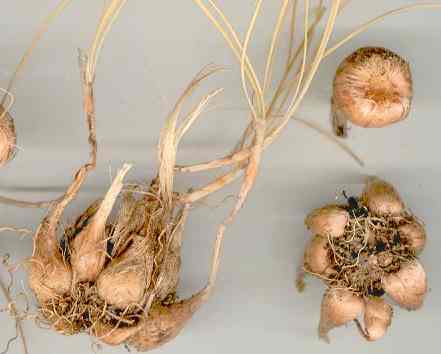 Saffron
is collected from Crocus sativus (Iridaceae),
which originated in the Middle Eastern region of the Eurasian
continent, from Greece to Persia (Iran). The plant does not
propagate by seeds; the underground portion, corms (also called
bulbs), divide to produce new plants. Flowers emerge in autumn; the
outstanding feature of the lilac to mauve colored flower is its three
stigmas 25–30 mm long, which droop over the petals: that is
what is collected as saffron. There are also three yellow stamens,
which lack the active compounds and are not collected. The stigma is
attached to a style, which has little of the active components and is
only included with the lower grades of saffron.
Saffron
is collected from Crocus sativus (Iridaceae),
which originated in the Middle Eastern region of the Eurasian
continent, from Greece to Persia (Iran). The plant does not
propagate by seeds; the underground portion, corms (also called
bulbs), divide to produce new plants. Flowers emerge in autumn; the
outstanding feature of the lilac to mauve colored flower is its three
stigmas 25–30 mm long, which droop over the petals: that is
what is collected as saffron. There are also three yellow stamens,
which lack the active compounds and are not collected. The stigma is
attached to a style, which has little of the active components and is
only included with the lower grades of saffron.
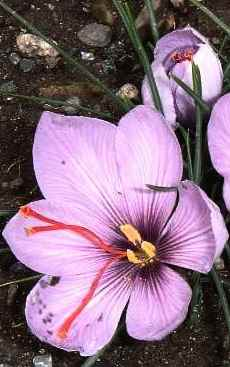
Each bulb produces from one to seven flowers. The cultivated form is thought to have originated as a naturally occurring hybrid that was selected for its extra-long stigmas, and has been maintained ever since. It takes about 36,000 flowers to yield just 1 pound of the stigmas.
Saffron has been cultivated in the region from Greece to Persia for 35 centuries and is mentioned in early literature, such as in the fourth of the Songs of Solomon, dated to about 965 B.C. Its cultivation and use spread throughout the region, moving east to Kashmir and west to Spain. The herb has been cultivated as far west as Britain and became an important medicinal in Tibet. Saffron was described in the Chinese compendium Bencao Gangmu (1596), indicating that it was introduced from Persia and used to benefit the blood (vitalizes blood, stops bleeding) and to calm fright.
Iran is the major saffron producer today, accounting for about 85 percent of the global production. The country produced 225 tons of saffron (April 2003–March 2004) and earned $67 million from saffron exports (only 10–15 tons were used domestically; most of the export goes to Spain). This year the Iranian saffron exports may reach $100 million. Spain is the second largest producer (35–40 tons/year) but is the primary international distributor; minor producers include Portugal, France, Italy, and Turkey. Kashmir has begun large scale production though it is not yet a major international source. Saffron has been successfully planted in several Chinese provinces, including Henan, Jiangsu, Hunan, Shanghai, and Tibet. A major problem with saffron production is that the plant grows in desert regions but needs sufficient water to thrive; irrigation in many of these areas is costly and difficult; severe draughts can cause significant crop losses.
SAFFRON AS A DYE
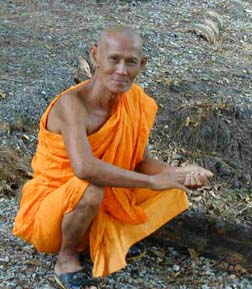 Historically,
saffron was particularly important as a dye plant. Saffron dye used
in small quantities will impart a yellowish-orange color, with
increasing redness as more is applied to color the cloth.
Historically,
saffron was particularly important as a dye plant. Saffron dye used
in small quantities will impart a yellowish-orange color, with
increasing redness as more is applied to color the cloth.
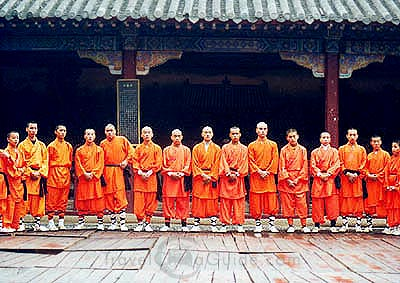 In
India, Tibet, and China, saffron has been used to produce the
yellow-red color of robes for Hindu and Buddhist monks. The main dye
component, crocin, a flavonoid, has also been found in the less
expensive gardenia fruit, which is now being developed as an
alternative source for dye purposes in China. Inexpensive
substitutes, such as the yellow color from turmeric, do not produce a
comparable color.
In
India, Tibet, and China, saffron has been used to produce the
yellow-red color of robes for Hindu and Buddhist monks. The main dye
component, crocin, a flavonoid, has also been found in the less
expensive gardenia fruit, which is now being developed as an
alternative source for dye purposes in China. Inexpensive
substitutes, such as the yellow color from turmeric, do not produce a
comparable color.
SAFFRON AS A MEDICINAL HERB
The
medicinal properties attributed to saffron are extensive. Topically,
it is applied to improve the skin condition overall and specifically
to treat acne. Internally, it is used to improve blood circulation,
regulate menstruation, treat digestive disturbance, ease cough and
asthmatic breathing, reduce fever and inflammation, calm nervousness,
and alleviate depression. In Tibet, saffron is often an ingredient
in medicinal incenses; it is considered a tonic for the heart and the
nervous system. The active ingredients may be of benefit in
inhibiting growth of cancer cells (7–10).
CONSTITUENTS
Saffron
has been analyzed extensively. It contains, approximately, these
common plant components:
Substance |
Proportion |
Simple sugars |
12–15% |
Water |
9–14% |
Proteins, amino acids, other nitrogen compounds |
11–13% |
Cellulose (fiber) |
4–7% |
Fats |
3–8% |
Minerals (measured as acid soluble ash) |
1–1.5% |
Other non-nitrogen (mainly complex sugars) |
about 40% |
And these active compounds:
Essential oil (volatile oil): 0.3–1.5%
Yellow color: crocins, derived from crocetin (about 2%),
and other carotenes (about 8%)
Bitter substances including picrocrocin and safranal
(the main aromatic of saffron): about 4%
The active constituents are degradation products of common carotenoids, mainly zeaxanthin (and, to a lesser extent, lycopene and beta-carotene), as illustrated below. Crocetin and the crocins provide far more color than the other carotenes. Picrocrocin, derived from the terminal end of zeaxanthin, is the glycoside of safranal, which is a terpene aldehyde. Safranal is formed during the drying of the collected saffron and it provides most of the characteristic saffron fragrance. There are other volatile components (included in the essential oil fraction) that are also derived from the carotenes and have structures similar to safranal.
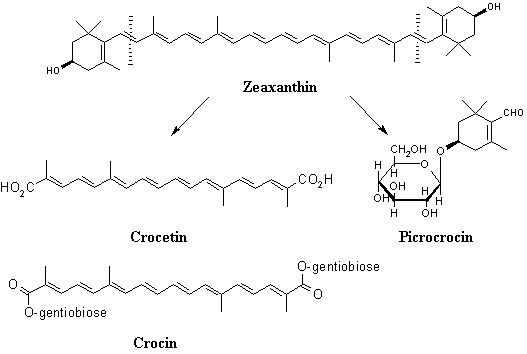
REFERNECES
- Akhondzadeh S, et al., Crocus sativus in the treatment of mild to moderate depression: a double-blind, randomized and placebo-controlled trial, Phytotherapy Research 2005; 19(2): 148–151.
- Akhondzadeh S, et al., Comparison of Crocus sativus and imipramine in the treatment of mild to moderate depression: a pilot double-blind randomized trial, Biomed Central Complementary and Alternative Medicine 2004; 4(1): 12.
- Noorbala AA, Hydro-alcoholic extract of Crocus sativus versus fluoxetine in the treatment of mild to moderate depression: a double-blind, randomized pilot trial, Journal of Ethnopharmacology 2005; 97(2): 281–284
- Hosseinzadeh H and Khosravan V, Anticonvulsant effects aqueous and ethanolic extracts of Crocus sativus stigmas in mice, Archives of Iranian Medicine 2002; 5: 44–47.
- Abe K, Saito H, Effects of saffron extract and its constituent crocin on learning behavior and long-term Potentiation, Phytother Res. 2000; 14: 149–52.
- Zhang Y, Shoyama Y, Sugiura M, Saito H, Effect of Crocus sativus on the ethanol-induced impairment of passive avoidance performances in mice, Biological and Pharmaceutical Bulletin 1994; 17: 217–221.
- Escribano J, et al., Crocin, safranal and picrocrocin from saffron (Crocus sativus) inhibit the growth of human cancer cells in vitro, Cancer Letters 1996; 100 (1–2): 23–30.
- Tarantilis PA, et al., Inhibition of growth and induction of differentiation of promyelocytic leukemia (HL-60) by carotenoids from Crocus sativus, Anticancer Research 1994; 14(5A): 1913–1918.
- Garcia-Olmo DC, Effects of long-term treatment of colon adenocarcinoma with crocin, a carotenoid from saffron (Crocus sativus): an experimental study in the rat, Nutrition and Cancer 1999; 35(2): 120–126.
- Abdullaev-Jafarova F and Espinosa-Aguirre JJ, Biomedical properties of saffron and its potential use in cancer therapy and chemoprevention trials, Cancer Detection and Prevention 2004; 28(6): 430–436.
May 2005